An AI chatbot is an app or interface that acts as a virtual support agent to automate customer query resolution. Follow along to learn all about AI chatbots.
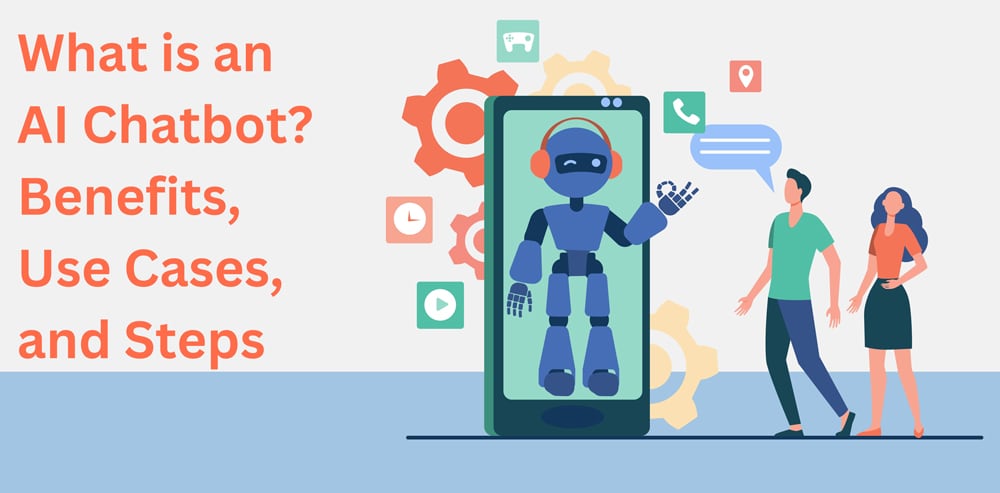
The current business era is an era of digitalisation and globalisation. Customer preferences are changing, and so are traditional customer service methods.
Today, AI chatbots are taking the spotlight, as businesses are actively integrating chatbots into their websites and other communication platforms, such as WhatsApp, Instagram, Messenger, and more. According to statistics, 58% of companies in the B2B sector and 42% of companies in the B2C sector are using chatbots.
In this guide, we will uncover all about AI chatbots, covering their basics, benefits, use-cases, and the steps to create one for your business. So, let’s get started!
What is an AI Chatbot?
An AI chatbot is a software or interface that can carry out human-like conversations with customers through written language. Think of it as a virtual assistant that can interact with customers and answer their queries in the same way as a human support agent.
An AI chatbot can help:
- Answer FAQs
- Generate leads
- Offer personalized product recommendations
- Provide how-to steps
- Process/track/return orders
- Collect customer feedback
- Interact in multiple languages
- Enable self-service
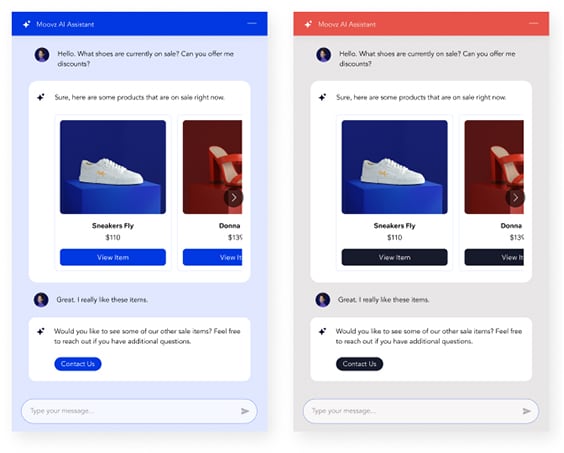
An AI chatbot is usually integrated with a website, app, or other communication platforms to automate customer interactions. In the background, an AI chatbot uses natural language processing (NLU) to interpret customer messages and offer the required response. Furthermore, it is pre-trained with a corporate knowledge base to provide accurate replies.
In short, an AI chatbot is a modernised approach to customer service that automates support and provides customers with personalised interactions.
Why is an AI Chatbot a Must for Businesses? 8 Benefits of Using AI Chatbot
Did you know that the number of apps/websites offering chatbot experiences has increased by 92% in recent years?
There are many reasons behind the widespread use of AI chatbots globally. The best way to understand is to look at what benefits businesses can get using AI chatbot:
1. 24/7 Customer Service
The top-most benefit of an AI chatbot is 24/7 customer service. An AI chatbot remains live 24/7 and can assist customers no matter the time of day. For example, if a customer visits your website at 2 a.m. and has a query about your product, they can use the AI chatbot to get the answers instantly. In fact, chatbots are able to handle entire conversations with customers about 69% of the time.
2. Instant and Consistent Responses
The AI chatbot provides instant and consistent responses. Customers don’t have to wait for the support agent to answer their queries. They can type the message and get the response in less than five seconds. Since an AI chatbot acts as a robot, it provides the same quality, consistent responses to all customers. This minimises complaints about inconsistent service quality.
3. Personalised Interaction and Shopping Assistance
83% of online shoppers require assistance during their shopping journey. An AI chatbot acts as their personal shopping assistant. It can understand their unique needs and then provide personalised recommendations. Moreover, it can tailor its conversation based on user preferences to give a personalised interaction experience.
4. Lead Generation
You will be amazed to know that 36% of businesses are actively using chatbots to uplift their lead-generation strategies. An AI chatbot is a great way to generate leads. Consider a real estate website as an example. An AI chatbot can interact with visitors and ask questions to understand their property preferences. Afterward, it can provide relevant suggestions and further talks to turn them into a potential lead.
5. Cost-Effectiveness
An AI chatbot requires an initial investment, but it offers faster ROI. There are two main reasons for that. First, it streamlines operations and drives sales. Second, it reduces the burden on human agents, which means smaller teams are needed. All these attributes lead to financial savings and business growth in the long run.
6. Scalability
The number of customers and their queries increases when the business grows. However, it is not an issue for the AI chatbot. The chatbot is capable of engaging with multiple customers at the same time. So, even if the number of customers increases, it can manage the growing queries without asking for additional resources.
7. Integration
An AI chatbot can integrate with multiple platforms, such as websites, mobile apps, social media platforms (WhatsApp, Instagram, Telegram, Discord, Messenger, etc.), and more. The best part is that you can integrate a single AI chatbot on multiple platforms.
8. Customer Engagement and Satisfaction
Chatbot is the key to improving customer engagement and satisfaction. 71% of customers want businesses to offer them personalised interactions. The chatbot can engage with customers through personalised conversation and offer instant and accurate responses. This eventually leads to improved customer satisfaction, which is reflected in repeat purchases and word-of-mouth marketing. In fact, 72% of customers share a positive experience with six or more people.
5 Real-World Examples of AI Chatbots
Almost all renowned brands and services have already integrated AI chatbots as a part of their customer service strategy. Let’s look at a few real-world examples of AI chatbots to better understand the usability of AI chatbots:

1. Temu
Temu is an e-commerce giant that sells almost all types of consumer goods. In fact, it was the most downloaded app in the App Store during H1 2024, with around 53.5 million installs. It has incorporated a powerful AI chatbot that offers 24/7 customer support.
Temu can answer general questions, handle order queries, manage refunds/returns, and more. It also offers a smooth handoff of chat to a human agent if the customer is not satisfied with the chatbot’s response. You can access the chatbot from the website or directly from Android/iOS apps.
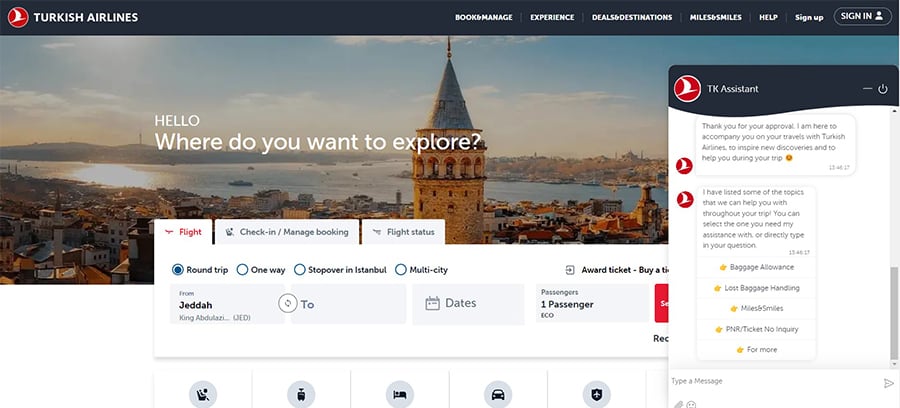
2. Turkish Airlines
Turkish Airlines is among the world’s largest airlines. It flies to around 265 international destinations in 130 countries. It has also integrated an AI chatbot that addresses travelers’ FAQs. The chatbot can provide answers related to ticket inquiries, lost baggage handling, baggage allowance, and more.
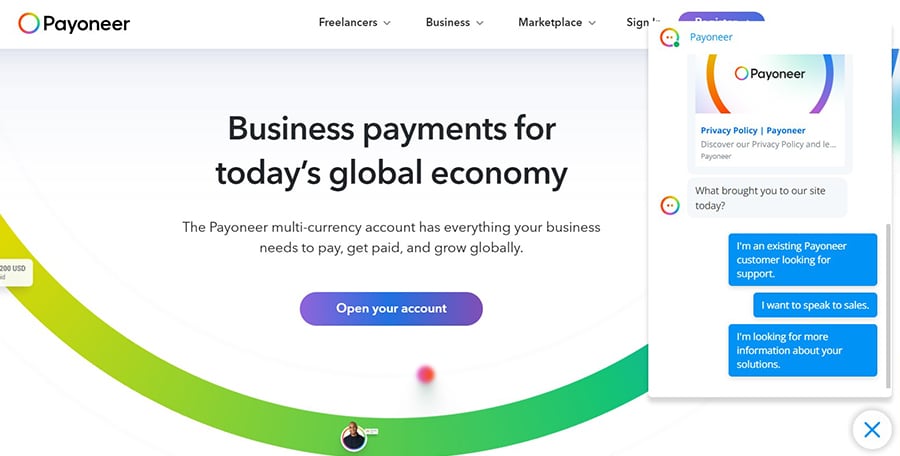
3. Payoneer
Payoneer is an online financial services company that helps businesses transfer and receive money in multiple currencies. It offers a powerful AI chatbot integrated into its website that can answer different queries related to account queries, payment issues, fee structures, and more. It can also transfer chats to human agents as per the user’s request.
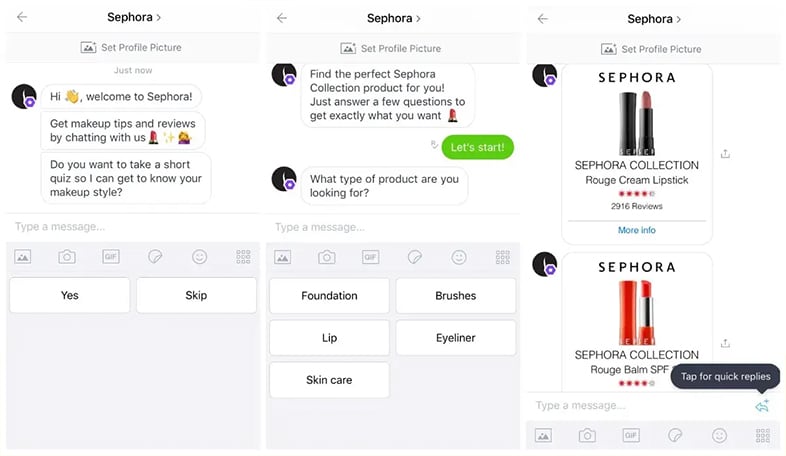
4. Sephora
Sephora is a globally recognised perfume and cosmetics brand. It offers an interactive chatbot that can engage with customers and convince them to make a purchase. For example, it can engage you with a short quiz to learn about your makeup style and then gradually recommend products based on your preferences.

5. CNN
CNN is a multinational news channel. It provides a Messenger-integrated AI chatbot that can suggest top stories or personalised news suggestions based on what it thinks you may like. You can also write keywords about specific subjects to get relevant news.
How to Create an AI Chatbot for Free?
Now that we have cleared the basics and necessity of AI chatbots, the next question is how to create one for free. Many business owners think creating an AI chatbot requires technical expertise and a coding background. However, the reality is completely opposite.
Creating an AI chatbot is easier than you think, without requiring any coding practices or complicated steps. Follow the below steps to learn how to create an AI chatbot within minutes:
Step 1. Identify the Chatbot’s Purpose
The first step is to identify the purpose/goal of a chatbot. You should be clear about what this chatbot is intended to offer. For example, if you are struggling with FAQs, you may want a chatbot that answers those queries autonomously. Similarly, you may want a chatbot for lead generation with personalised recommendations.
Therefore, it is important to know the end goals you want to achieve with chatbots. Based on that, you will be able to move in the right direction.
Step 2. Finalise Where to Integrate the Chatbot
An AI chatbot can integrate with:
- Websites
- Mobile apps
- Social media platforms
- E-commerce platforms like Shopify, WooCommerce, etc.
- And many more
The platform you choose to integrate the chatbot with depends on your business model and customers’ preferred communication channels.
Step 3. Choose the Chatbot Builder Platform
Next, you have to choose the chatbot builder platform. If you Google “chatbot builder”, you will find plenty of platforms to choose from.
You should choose a platform that offers an easy-to-use interface for building a chatbot, advanced features for creating a highly capable AI chatbot, and support for integrating with platforms of your choice.
Step 4. Use the Chatbot Editor to Design the Chatbot Flow
Once you have finalised the chatbot platform, you should begin designing the chatbot flow in the editor. This involves adding building blocks to configure how you want the chatbot to interact and engage with customers from start to finish.
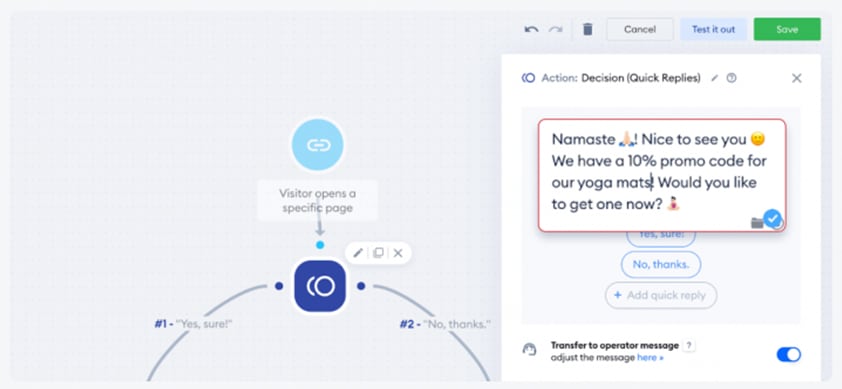
Step 5. Train the Chatbot with Your Corporate Knowledge Base
Now that the chatbot flow is finalised, you should train the bot with your corporate knowledge base. Most chatbot builders allow uploading PDFs, docs, spreadsheets, website URLs, and more and can then intelligently extract useful information from the documents. So, upload all your corporate knowledge base to train the chatbot.
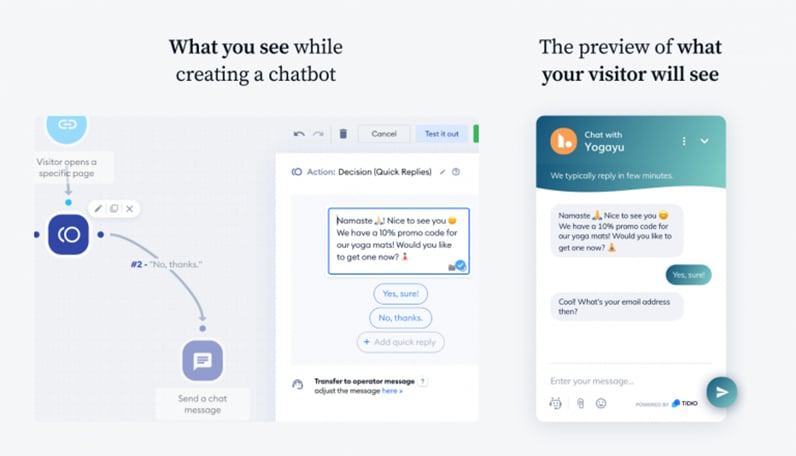
Step 6. Test and Debug the Chatbot
After training the chatbot, use the Debug mode of the chatbot builder to test its responses to different queries. You can also edit and optimise incorrect responses.
Step 7. Publish and Integrate the Chatbot
Once the AI chatbot design is finalised, you can publish and integrate it with your preferred channel. To complete the integration, you will have to follow the on-screen instructions.
Step 8. Monitor Chatbot Performance and Optimise It
Now that the AI chatbot is live, you should regularly monitor its performance and see how well it assists your customers. You can look at the analytics the chatbot platform shares, identify improvement areas, and optimise the chatbot’s performance.

5 Best Practices for AI Chatbots
It is not just about creating and integrating chatbots but also about offering customers the best experience. In this perspective, below are a few best practices for AI chatbots:
- Use Large Language Models (LLMs): Use LLM-powered chatbots, like OpenAI GPT or Meta Llama, to have more capable chatbots.
- Focus on User Experience (UX): Create a chatbot that is easy to use, offers an appealing interface, and provides accurate and fast responses.
- Integrate with Multiple Channels: Integrate the chatbot with multiple channels to offer chatbot access to customers on their preferred channels and maximise reach
- Support Human Chat Handoff: Customers should be able to talk to human agents when needed.
- Improve Performance: Keep an eye on chatbot performance and regularly improve its responses and knowledge base with new business updates and best practices.
In short, it takes time and effort to create a comprehensive chatbot that can delight customers, provide consistent responses, and drive business growth.
Conclusion
AI chatbots are the game-changer for customer service. They automate customer support, increase customer engagement, drive sales, and more. Moreover, they have become necessary rather than a choice to remain competitive in today’s interconnected world. Therefore, it’s time for action. Finalise the goal of your AI chatbot and begin creating a full-fledged chatbot for your business.
It takes courage to innovate and transform your customer service approach, but the rewards are worth the effort. Start today and watch your business thrive!
